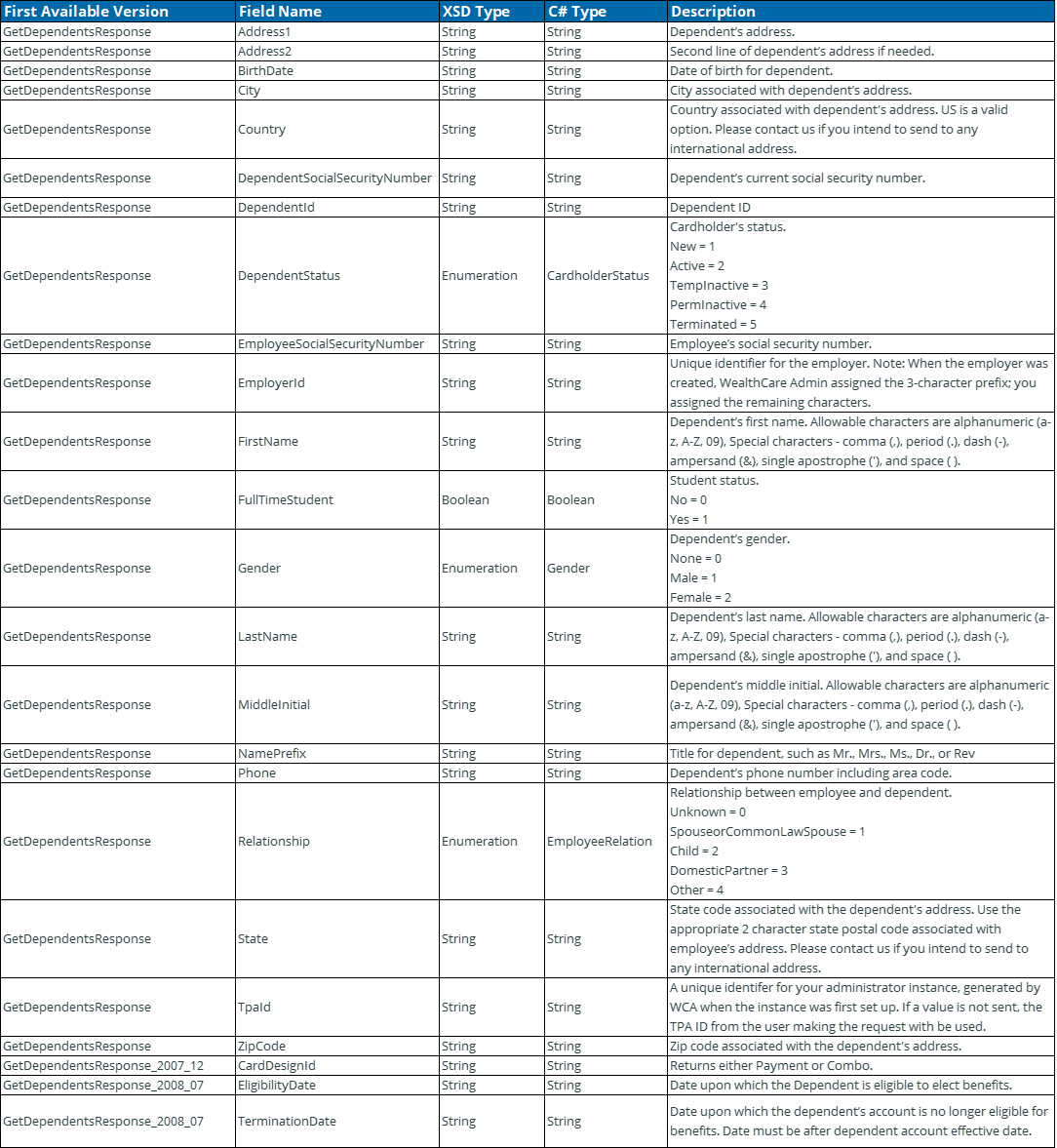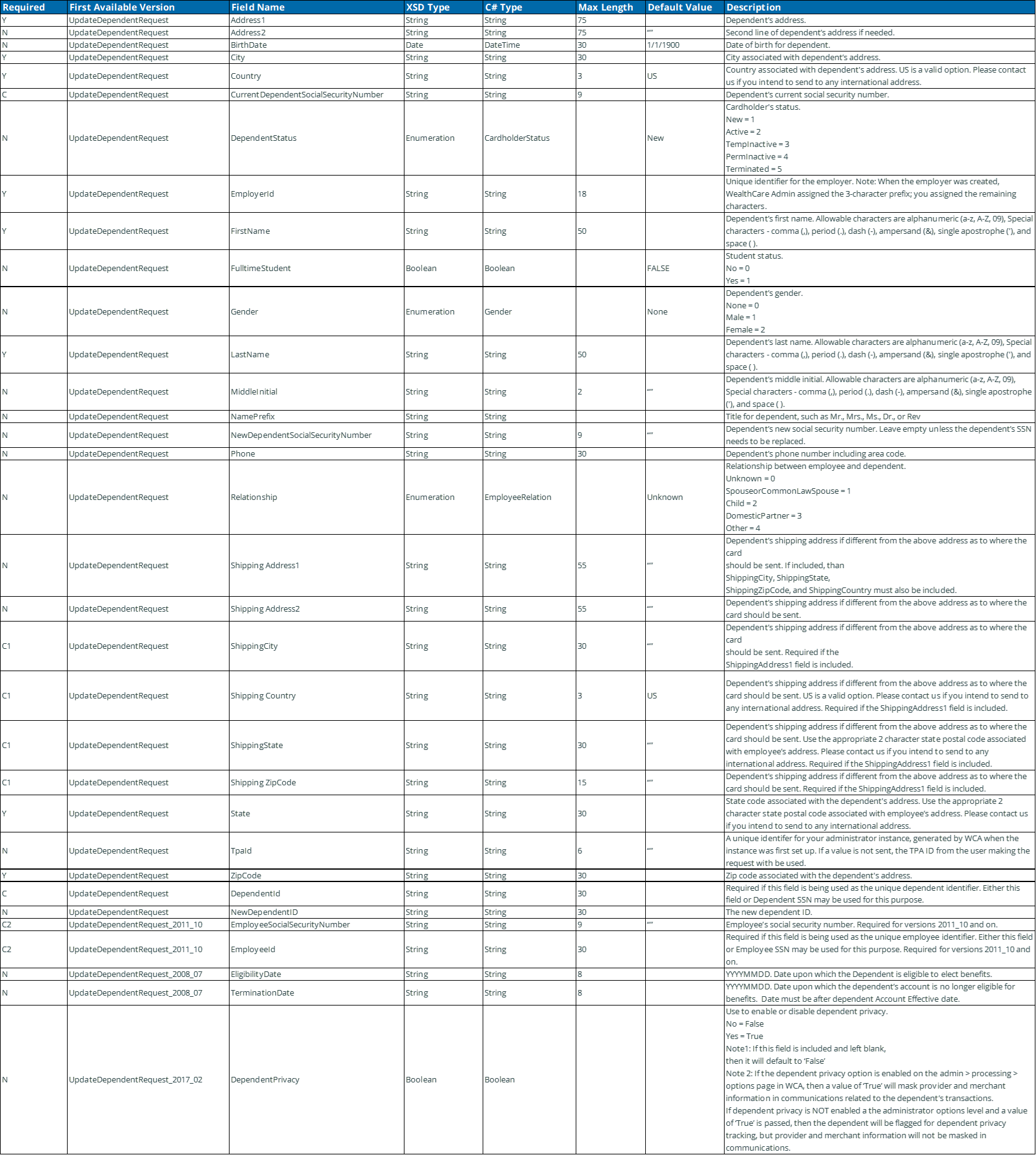
Dependent API | Administrative - SOAP
The Dependent Service provides clients dependent functionalities such as reading, adding, updating, and deleting dependents’ information.
Important Note: In order to facilitate backward compatibility with all Web Services in use prior to June 4, 2005, either Employee (Dependent) Social Security Number (previously used as unique employee/dependent identifier) or Employee (Dependent) ID (new unique employee/dependent identifier) may be provided when required to uniquely identify an employee or dependent. If both are provided, the Employer (Dependent) ID is used as the unique identifier. When adding or updating employee or dependent demographic information (specifically, the “True” Social Security Number field), the following rules apply:
If only the Employee (Dependent) ID is provided, it is used as the unique identifier, and the “True” SSN field is not be added or updated.
If only the Employee (Dependent) Social Security Number is provided, it is be used as the unique identifier, and the “True” SSN field is not added or updated.
If both the Employee (Dependent) ID and the Employee (Dependent) Social Security Number are provided, the Employee (Dependent) ID is used as the unique identifier and the Employee (Dependent) Social Security Number is used to add/update the “True” SSN.
Service Web Methods
The following is a list of methods that are provided by the Dependent Service.
AddDependent – used to add a dependent’s demographic information
DeleteDependent – used to remove information about a dependent
GetDependent - to get information about an employee’s dependent
GetDependents – used to retrieve an employee’s list of dependents
UpdateDependent – used to update a dependent’s demographic information that already exists
Service Assumptions/Business Rules
The Dependent Service makes the following assumptions as well as enforce the following business rules.
Clients shall conform to the WS-I specifications unless otherwise agreed upon by Alegeus Technologies and the administrator.
Clients shall format SOAP messages in a Document/Literal format over HTTPS.
Clients shall have already created a valid user ID and password.
Clients shall have a valid session ID after being authenticated by the system. The session ID needs to be passed in the proper manner as described in the Account Manager Service Guide.
If the administrator uses the same user ID and password for all of their clients, the administrators are responsible for managing the security of the data.
Clients should validate data before submitting a request to this Service. This facilitates better performance and accurate processing on both systems.
Clients shall not attempt to use this service for batch processing of large amounts of data. The service is designed for synchronous calls that send or retrieve small chunks of data. If batch processing is required, then the EDI process should be used.
If any method fails, the service returns a SOAP fault describing the problem.
AddDependent
This method is used to add a dependent’s demographic information to the system.
History
The AddDependent methods are listed below:
Request Message
AddDependentRequest_2008_07
AddDependentRequest
Response Message
AddDependentResponse
AddDependent Request/Response Messages
The AddDependent method requires the following request and response messages (input and output data). The table below includes the following request message:
AddDependentRequest_2008_07
AddDependentRequest

Response Message: Empty Message
Example of an AddDependent SOAP request message
<?xml version="1.0" encoding="utf-8" ?>
<soap:Envelope xmlns:soap="http://schemas.xmlsoap.org/soap/envelope/" xmlns:xsi="http://www.w3.org/2001/XMLSchema-instance" xmlns:xsd="http://www.w3.org/2001/XMLSchema">
<soap:Header>
<MBISessionHeader xmlns="http://www.medibank.com/MBIWebServices/SoapHeader/">
<MBISessionID>o3kaamaa2u4khf450irosiin</MBISessionID>
</MBISessionHeader>
</soap:Header>
<soap:Body>
<AddDependent xmlns="http://www.medibank.com/MBIWebServices/Employee/Messages/Dependent/Request/2004/06/"> <addDependentRequest>
<Address1>234 Western St</Address1>
<BirthDate>1965-01-01</BirthDate>
<City>EasternTown</City>
<DependentSocialSecurityNumber>122132876</DependentSocialSecurityNumber>
<EmployeeSocialSecurityNumber>332323232</EmployeeSocialSecurityNumber>
<EmployerId>EASE10</EmployerId>
<FirstName>Southe</FirstName>
<Gender xmlns="http://www.medibank.com/MBIWebServices/Enums/">Female</Gender>
<LastName>EastWood</LastName>
<MiddleInitial />
<NamePrefix>Mrs.</NamePrefix>
<Phone />
<Relationship xmlns="http://www.medibank.com/MBIWebServices/Enums/">Spouse</Relationship>
<ShippingCountry />
<State>MA</State>
<TpaId>T00209</TpaId>
<ZipCode>087654</ZipCode>
</addDependentRequest>
</AddDependent>
</soap:Body>
</soap:Envelope>
Example of an AddDependent SOAP response message
<?xml version="1.0" encoding="utf-8" ?>
<soap:Envelope xmlns:soap="http://schemas.xmlsoap.org/soap/envelope/" xmlns:xsi="http://www.w3.org/2001/XMLSchema-instance" xmlns:xsd="http://www.w3.org/2001/XMLSchema">
<soap:Header>
<MBIMessageIdHeader xmlns="http://www.medibank.com/MBIWebServices/SoapHeader/" />
</soap:Header>
<soap:Body>
<AddDependentResponse xmlns="http://www.medibank.com/MBIWebServices/Employee/Messages/Dependent/Response/2004/06/">
<AddDependentResult />
</AddDependentResponse>
</soap:Body>
</soap:Envelope>
Example Client Code
The following is an example of the client code (using a .NET proxy class for accessing the service) used when adding an employee using the AddDependent web method.
try
{
// Create the session SOAP header in order to pass the Service // the client’s current session id.
mbiSessionHeader = new DependentServiceNameSpace.MBISessionHeader();
// Create proxy object for the Dependent service
proxy = new DependentServiceNameSpace.DependentService();
// Create request message for method call (input parameters) request = new DependentServiceNameSpace.AddDependentRequest();
// Set the input parameters
request.Address1 = _address1.Text;
request.Address2 = _address2.Text;
if(_birthDate.Text.Length > 0)
{
request.BirthDate = Convert.ToDateTime(_birthDate.Text);
}
request.City = _city.Text;
request.Country = _country.Text;
request.DependentSocialSecurityNumber = _depSSN.Text;
request.EmployeeSocialSecurityNumber = _empeSSN.Text;
request.EmployerId = _emprId.Text;
request.FirstName = _firstName.Text;
request.FullTimeStudent = (bool)_fulltimeStudent.SelectedItem;
request.Gender = (DependentServiceNameSpace.Gender)_gender.SelectedItem; request.LastName = _lastName.Text;
request.MiddleInitial = _middleInitial.Text;
request.NamePrefix = _namePrefix.Text;
request.Phone = _phone.Text; request.Relationship = (DependentServiceNameSpace.EmployeeRelation)
_relationship.SelectedItem;
request.ShippingAddress1 = _shippingAddress1.Text;
request.ShippingAddress2 = _shippingAddress2.Text;
request.ShippingCity = _shippingCity.Text;
request.ShippingCountry = _shippingCountry.Text;
request.ShippingState = _shippingState.Text;
request.ShippingZipCode = _shippingZipCode.Text;
request.State = _state.Text;
request.TpaId = _tpaId.Text; request.ZipCode = _zipCode.Text;
// session ID returned from login method
mbiSessionHeader.MBISessionID = _sessionId.Text;
proxy.MBISessionHeaderValue = mbiSessionHeader;
// Call the method
response = proxy.AddDependent(request);
MessageBox.Show("Finished.");
}
DeleteDependent
This method is used to remove information about a dependent from the system.
History
The DeleteDependent methods are listed below:
Request Message
DeleteDependentRequest_2011_10
DeleteDependentRequest
Response Message
DeleteDependentResponse
DeleteDependent Request/Response Messages
The DeleteDependent method requires the following request and response messages (input and output data). The table below includes the following request message:
• DeleteDependentRequest

Response Message: Empty Message
Example of a DeleteDependent SOAP request message
<?xml version="1.0" encoding="utf-8" ?>
<soap:Envelope xmlns:soap="http://schemas.xmlsoap.org/soap/envelope/" xmlns:xsi="http://www.w3.org/2001/XMLSchema-instance" xmlns:xsd="http://www.w3.org/2001/XMLSchema">
<soap:Header>
<MBISessionHeader xmlns="http://www.medibank.com/MBIWebServices/SoapHeader/">
<MBISessionID>org3b4454knvat45da0insnt</MBISessionID>
</MBISessionHeader>
</soap:Header>
<soap:Body>
<DeleteDependent xmlns="http://www.medibank.com/MBIWebServices/Employee/Messages/Dependent/Request/2004/06/"> <deleteDependentRequest>
<DependentSocialSecurityNumber>222222222</DependentSocialSecurityNumber>
<EmployeeSocialSecurityNumber>332323232</EmployeeSocialSecurityNumber>
<EmployerId>EASE10</EmployerId>
<TpaId>T00209</TpaId>
</deleteDependentRequest>
</DeleteDependent>
</soap:Body>
</soap:Envelope>
Example of a DeleteDependent SOAP response message
<?xml version="1.0" encoding="utf-8" ?>
<soap:Envelope xmlns:soap="http://schemas.xmlsoap.org/soap/envelope/" xmlns:xsi="http://www.w3.org/2001/XMLSchema-instance" xmlns:xsd="http://www.w3.org/2001/XMLSchema">
<soap:Header>
<MBIMessageIdHeader xmlns="http://www.medibank.com/MBIWebServices/SoapHeader/" />
</soap:Header>
<soap:Body>
<DeleteDependentResponse xmlns="http://www.medibank.com/MBIWebServices/Employee/Messages/Dependent/Response/2004/06/"> <DeleteDependentResult />
</DeleteDependentResponse>
</soap:Body>
</soap:Envelope>
Example Client Code
The following is an example of the client code (using a .NET proxy class to connect with the service) used when calling the DeleteDependent method.
try
{
// Create the session SOAP header in order to pass the Service // the client’s current session id.
mbiSessionHeader = new DependentServiceNameSpace.MBISessionHeader();
// Create proxy object for the Dependent service
proxy = new DependentServiceNameSpace.DependentService();
// Create request message for method call (input parameters)
request = new DependentServiceNameSpace.DeleteDependentRequest();
// Set the input parameters
request.DependentSocialSecurityNumber = _dependentSocialSecurityNumber.Text;
request.EmployeeSocialSecurityNumber = _employeeSocialSecurityNumber.Text;
request.EmployerId = _employerId.Text;
request.TpaId = _tpaId.Text;
// session ID returned from login method
mbiSessionHeader.MBISessionID = _sessionId.Text;
proxy.MBISessionHeaderValue = mbiSessionHeader;
// Call the method
response = proxy.DeleteDependent(request);
MessageBox.Show("Finished.");
}
catch(SoapException se)
{
// perform needed operations
}
catch(Exception ex)
{
// perform needed operations
}
GetDependent
This method is used to get information about an employee’s dependent.
History
The GetDependent methods are listed below:
Request Message
GetDependentRequest_2011_10
GetDependentRequest
Response Message
GetDependentResponse_2008_07
GetDependentResponse_2007_12
GetDependentResponse
GetDependent Request/Response Messages
The GetDependent method requires the following request and response messages (input and output data). The table below includes the following request message:
GetDependentRequest

The table below includes the following response message:
GetDependentResponse_2008_07
GetDependentResponse_2007_12
GetDependentResponse

Example of a GetDependent SOAP request message
<?xml version="1.0" encoding="utf-8" ?>
<soap:Envelope xmlns:soap="http://schemas.xmlsoap.org/soap/envelope/" xmlns:xsi="http://www.w3.org/2001/XMLSchema-instance" xmlns:xsd="http://www.w3.org/2001/XMLSchema">
<soap:Header>
<MBISessionHeader xmlns="http://www.medibank.com/MBIWebServices/SoapHeader/">
<MBISessionID>org3b4454knvat45da0insnt</MBISessionID>
</MBISessionHeader>
</soap:Header>
<soap:Body>
<GetDependent xmlns="http://www.medibank.com/MBIWebServices/Employee/Messages/Dependent/Request/2004/06/"> <GetDependentRequest>
<DependentSocialSecurityNumber>222222222</DependentSocialSecurityNumber>
<EmployeeSocialSecurityNumber>332323232</EmployeeSocialSecurityNumber>
<EmployerId>EASE10</EmployerId>
<TpaId>T00209</TpaId>
</GetDependentRequest>
</GetDependent>
</soap:Body>
</soap:Envelope>
Example of a GetDependent SOAP response message
<?xml version="1.0" encoding="utf-8" ?>
<soap:Envelope xmlns:soap=http://schemas.xmlsoap.org/soap/envelope/ xmlns:xsi="http://www.w3.org/2001/XMLSchema-instance" xmlns:xsd="http://www.w3.org/2001/XMLSchema">
<soap:Header>
<MBIMessageIdHeader xmlns="http://www.medibank.com/MBIWebServices/SoapHeader/" />
</soap:Header>
<soap:Body>
<GetDependentResponse xmlns="http://www.medibank.com/MBIWebServices/Employee/Messages/Dependent/Response/2004/06/">
<GetDependentResult>
<Address1>dsdsds</Address1>
<Address2 />
<BirthDate>20020101</BirthDate>
<City>jkkjbj</City>
<Country>US</Country>
<DependentSocialSecurityNumber>222222222</DependentSocialSecurityNumber>
<DependentStatus xmlns="http://www.medibank.com/MBIWebServices/Enums/">New</DependentStatus>
<EmployerId>EASE10</EmployerId>
<FirstName>mmn</FirstName>
<FullTimeStudent>false</FullTimeStudent>
<Gender xmlns="http://www.medibank.com/MBIWebServices/Enums/">None</Gender>
<LastName>mnbnm</LastName>
<MiddleInitial />
<NamePrefix />
<Phone />
<Relationship xmlns="http://www.medibank.com/MBIWebServices/Enums/">Unknown</Relationship>
<ShippingAddress1 />
<ShippingAddress2 />
<ShippingCity />
<ShippingCountry />
<ShippingState />
<ShippingZipCode />
<State>MA</State>
<TpaId>T00209</TpaId>
<ZipCode>83243</ZipCode>
</GetDependentResult>
</GetDependentResponse>
</soap:Body>
</soap:Envelope>
Example Client Code
The following is an example of the client code (using a .NET proxy class to connect to the service) used when calling the GetDependent method.
try
{
_dataset.Tables["Dependents"].Clear();
// Create the session SOAP header in order to pass the Service
// the client’s current session id.
mbiSessionHeader = new DependentServiceNameSpace.MBISessionHeader();
// Create proxy object for the Dependent service
proxy = new DependentServiceNameSpace.DependentService();
// Create request message for method call (input parameters)
request = new DependentServiceNameSpace.GetDependentRequest();
// Set the input parameters
request.DependentSocialSecurityNumber = _dependentSocialSecurityNumber.Text;
request.EmployeeSocialSecurityNumber = _employeeSocialSecurityNumber.Text;
request.EmployerId = _employerId.Text;
request.TpaId = _tpaId.Text;
request.VerboseMode = Convert.ToBoolean(_verboseMode.Text);
// session ID returned from logon method
mbiSessionHeader.MBISessionID = _sessionId.Text;
proxy.MBISessionHeaderValue = mbiSessionHeader;
response = proxy.GetDependent(request);
if(response != null)
{
_dataset.Tables["Dependents"].Rows.Add(new string[]
{
response.Address1,
response.Address2,
response.BirthDate,
response.City,
response.Country,
response.DependentSocialSecurityNumber,
response.DependentStatus.ToString(),
response.EmployerId,
response.FirstName,
response.FullTimeStudent.ToString(),
response.Gender.ToString(),
response.LastName,
response.MiddleInitial,
response.NamePrefix,
response.Phone,
response.Relationship.ToString(),
response.ShippingAddress1,
response.ShippingAddress2,
response.ShippingCity,
response.ShippingCountry,
response.ShippingState,
response.ShippingZipCode,
response.State,
response.TpaId,
response.ZipCode
});
}
}
catch(SoapException se)
{
// perform needed operations
}
catch(Exception ex)
{
// perform needed operations
}
GetDependents
This method is used to get a list of dependents for a given employee.
History
The GetDependents methods are listed below:
Request Message
GetDependentsRequest
Response Message
GetDependentsResponse_2008_07
GetDependentsResponse_2007_12
GetDependentsResponse
GetDependents Request/Response Messages
The GetDependents method requires the following request and response messages (input and output data). The table below includes the following request message:
• GetDependentsRequest

The table below includes the following response message:
GetDependentsResponse_2008_07
GetDependentsResponse_2007_12
GetDependentsResponse

Example of a GetDependents SOAP request message
<?xml version="1.0" encoding="utf-8" ?>
<soap:Envelope xmlns:soap="http://schemas.xmlsoap.org/soap/envelope/" xmlns:xsi="http://www.w3.org/2001/XMLSchema-instance" xmlns:xsd="http://www.w3.org/2001/XMLSchema">
<soap:Header>
<MBISessionHeader xmlns="http://www.medibank.com/MBIWebServices/SoapHeader/">
<MBISessionID>org3b4454knvat45da0insnt</MBISessionID>
</MBISessionHeader>
</soap:Header>
<soap:Body>
<GetDependents xmlns="http://www.medibank.com/MBIWebServices/Employee/Messages/Dependent/Request/2004/06/"> <getDependentsRequest>
<EmployeeSocialSecurityNumber>332323232</EmployeeSocialSecurityNumber>
<EmployerId>EASE10</EmployerId>
<TpaId>T00209</TpaId>
</getDependentsRequest>
</GetDependents>
</soap:Body>
</soap:Envelope>
Example of a GetDependents SOAP response message
<?xml version="1.0" encoding="utf-8" ?>
<soap:Envelope xmlns:soap="http://schemas.xmlsoap.org/soap/envelope/" xmlns:xsi="http://www.w3.org/2001/XMLSchema-instance" xmlns:xsd="http://www.w3.org/2001/XMLSchema">
<soap:Header>
<MBIMessageIdHeader xmlns="http://www.medibank.com/MBIWebServices/SoapHeader/" />
</soap:Header>
<soap:Body>
<GetDependentsResponse xmlns="http://www.medibank.com/MBIWebServices/Employee/Messages/Dependent/Response/2004/06/">
<GetDependentsResult>
<GetDependentsResponse>
<Address1>dsdsds</Address1>
<Address2 />
<BirthDate>20020101</BirthDate>
<City>jkkjbj</City>
<Country>US</Country>
<DependentSocialSecurityNumber>222222222</DependentSocialSecurityNumber>
<DependentStatus xmlns="http://www.medibank.com/MBIWebServices/Enums/">New</DependentStatus>
<EmployeeSocialSecurityNumber>222222222</EmployeeSocialSecurityNumber>
<EmployerId>EASE10</EmployerId>
<FirstName>mmn</FirstName>
<FullTimeStudent>false</FullTimeStudent>
<Gender xmlns="http://www.medibank.com/MBIWebServices/Enums/">None</Gender>
<LastName>mnbnm</LastName>
<MiddleInitial />
<NamePrefix />
<Phone />
<Relationship xmlns="http://www.medibank.com/MBIWebServices/Enums/">Unknown</Relationship>
<State>MA</State>
<TpaId>T00209</TpaId>
<ZipCode>83243</ZipCode>
</GetDependentsResponse>
</GetDependentsResult>
</GetDependentsResponse>
</soap:Body>
</soap:Envelope>
Example Client Code
The following is an example of the client code (using a .NET proxy class to connect to the service) used when calling the GetDependents method.
try
{
_dataset.Tables["Dependents"].Clear();
// Create the session SOAP header in order to pass the Service
// the client’s current session id.
mbiSessionHeader = new DependentServiceNameSpace.MBISessionHeader();
// Create proxy object for the Dependent service
proxy = new DependentServiceNameSpace.DependentService();
// Create request message for method call (input parameters)
request = new DependentServiceNameSpace.GetDependentsRequest();
// Set the input parameters
request.EmployeeSocialSecurityNumber = _employeeSocialSecurityNumber.Text;
request.EmployerId = _employerId.Text;
request.TpaId = _tpaId.Text;
request.VerboseMode = Convert.ToBoolean(_verboseMode.Text);
// session ID returned from logon method
mbiSessionHeader.MBISessionID = _sessionId.Text;
proxy.MBISessionHeaderValue = mbiSessionHeader;
responses = proxy.GetDependents(request);
if(responses != null)
{
for(int i=0; i < responses.Length; i++)
{
_dataset.Tables["Dependents"].Rows.Add(new string[] {
// set results
});
}
}
}
catch(SoapException se)
{
// perform needed operations
}
catch(Exception ex)
{
// perform needed operations
}
UpdateDependent
This method is used to update a dependent’s demographic information. The dependent must already exist within the system.
History
The UpdateDependent methods are listed below:
Request Message
UpdateDependentRequest_2011_10
UpdateDependentRequest_2008_07
UpdateDependentRequest
Response Message
UpdateDependentResponse
UpdateDependent Request/Response Messages
The UpdateDependent method requires the following request and response messages (input and output data).
The table below includes the following request message:
UpdateDependentRequest_2008_07
UpdateDependentRequest

Response Message: Empty Message
Example of an UpdateDependent SOAP request message
<?xml version="1.0" encoding="utf-8" ?>
<soap:Envelope xmlns:soap="http://schemas.xmlsoap.org/soap/envelope/" xmlns:xsi="http://www.w3.org/2001/XMLSchema-instance" xmlns:xsd="http://www.w3.org/2001/XMLSchema">
<soap:Header>
<MBISessionHeader xmlns="http://www.medibank.com/MBIWebServices/SoapHeader/">
<MBISessionID >org3b4454knvat45da0insnt</MBISessionID>
</MBISessionHeader>
</soap:Header>
<soap:Body>
<UpdateDependent xmlns="http://www.medibank.com/MBIWebServices/Employee/Messages/Dependent/Request/2004/06/">
<Address1>123 South St</Address1>
<Address2>apt 2</Address2>
<BirthDate>1965-01-01</BirthDate>
<City>Worcester</City>
<CurrentDependentSocialSecurityNumber>222222222</CurrentDependentSocialSecurityNumber>
<DependentStatus xmlns="http://www.medibank.com/MBIWebServices/Enums/">Active</DependentStatus>
<EmployerId>EASE10</EmployerId>
<FirstName>Bill</FirstName>
<FullTimeStudent>true</FullTimeStudent>
<Gender xmlns="http://www.medibank.com/MBIWebServices/Enums/">Male</Gender>
<LastName>Smith</LastName>
<MiddleInitial />
<NamePrefix>Mr.</NamePrefix>
<Phone>555 555-5555</Phone>
<Relationship xmlns="http://www.medibank.com/MBIWebServices/Enums/">Child</Relationship>
<ShippingCountry />
<State>MA</State>
<TpaId>T00209</TpaId>
<ZipCode>12345</ZipCode>
</updateDependentRequest>
</UpdateDependent>
</soap:Body>
</soap:Envelope>
Example of a UpdateDependent SOAP response message
<?xml version="1.0" encoding="utf-8" ?>
<soap:Envelope xmlns:soap="http://schemas.xmlsoap.org/soap/envelope/" xmlns:xsi="http://www.w3.org/2001/XMLSchema-instance" xmlns:xsd="http://www.w3.org/2001/XMLSchema">
<soap:Header>
<MBIMessageIdHeader xmlns="http://www.medibank.com/MBIWebServices/SoapHeader/" />
</soap:Header>
<soap:Body>
<UpdateDependentResponse xmlns="http://www.medibank.com/MBIWebServices/Employee/Messages/Dependent/Response/2004/06/">
<UpdateDependentResult />
</UpdateDependentResponse>
</soap:Body>
</soap:Envelope>
Example Client Code
The following is an example of the client code (using a .NET proxy class to connect with the service) used when calling the UpdateDependent method.
try
{
// Create the session SOAP header in order to pass the Service
// the client’s current session id.
mbiSessionHeader = new DependentServiceNameSpace.MBISessionHeader();
// Create proxy object for the Dependent service
proxy = new DependentServiceNameSpace.DependentService();
// Create request message for method call (input parameters)
request = new DependentServiceNameSpace.UpdateDependentRequest();
// Set the input parameters
request.Address1 = _address1.Text;
request.Address2 = _address2.Text;
if(_birthDate.Text.Length > 0)
{
request.BirthDate = Convert.ToDateTime(_birthDate.Text);
}
request.City = _city.Text;
request.Country = _country.Text;
request.CurrentDependentSocialSecurityNumber = _currentDepSSN.Text;
request.NewDependentSocialSecurityNumber = _newDepSSN.Text;
request.DependentStatus = (DependentServiceNameSpace.CardholderStatus)
_depStatus.SelectedItem;
request.EmployerId = _emprId.Text;
request.FirstName = _firstName.Text;
request.FullTimeStudent = (bool)_fulltimeStudent.SelectedItem;
request.Gender = (DependentServiceNameSpace.Gender)_gender.SelectedItem;
request.LastName = _lastName.Text;
request.MiddleInitial = _middleInitial.Text;
request.NamePrefix = _namePrefix.Text;
request.Phone = _phone.Text; request.Relationship = (DependentServiceNameSpace.EmployeeRelation)
_relationship.SelectedItem;
request.ShippingAddress1 = _shippingAddress1.Text;
request.ShippingAddress2 = _shippingAddress2.Text;
request.ShippingCity = _shippingCity.Text;
request.ShippingCountry = _shippingCountry.Text;
request.ShippingState = _shippingState.Text;
request.ShippingZipCode = _shippingZipCode.Text;
request.State = _state.Text; request.TpaId = _tpaId.Text;
request.ZipCode = _zipCode.Text;
// session ID returned from login method
mbiSessionHeader.MBISessionID = _sessionId.Text;
proxy.MBISessionHeaderValue = mbiSessionHeader;
// Call the method
response = proxy.UpdateDependent(request);
MessageBox.Show("Finished.");
}
catch(SoapException se)
{
// perform needed operations
}
catch(Exception ex)
{
// perform needed operations
}
Copyright © 2023 Alegeus Technologies, LLC. All rights reserved. Alegeus, Alegeus Technologies, WealthCare, WealthCare Saver are registered trademarks of Alegeus Technologies, LLC